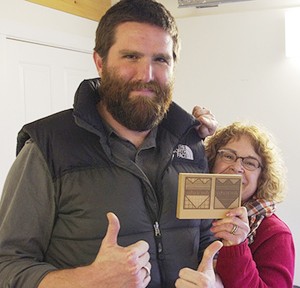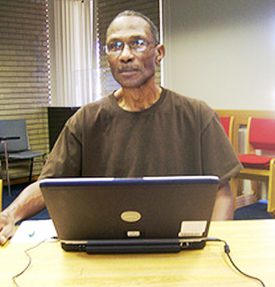Make. Connect. Learn.

Proud maker at Fayetteville Free Library FabLab;
photo by AS220 on Flickr
Teaching patrons in the 21st century
”Learn by doing. Learn by making. Not learn by clicking.” (Audrey Watters)
There is a blitz of digital literacy initiatives in libraries across the nation as the imperatives mount for all citizens to get up to speed on 21st century skills and tools. Our increasingly digital culture demands technology skills for the workplace, for the employment process, for GED tests, for access to health and affordable care information, and for civic and social engagement. At the same time, there is a rising tide of makerspaces percolating into library spaces, or setting up in collaboration with libraries. Is there a connection between these two trends?
Fabricating 21st century skills
In the early 1980s, Seymour Papert introduced the learning theory of constructionism, which posits that the world is understood through being uniquely constructed by the individual. Whether making tangible objects or solving more abstract problems, there is a process of personal experimentation and discovery that makes the learning meaningful for each student. Now in the thick of the Information Age, the theory of connected learning affirms a strong association between learning and making as a trigger for curiosity and the imagination. The connected learning environment facilitates hands-on, participatory, interest-powered, peer-supported learning. A summary report of connected learning research, An Agenda for Research and Design, correlates the practice with 21st century literacies: “systems thinking, information literacy, creativity, adaptability, conscientiousness, persistence, global awareness and self-regulation.” This list of skill sets echoes those outlined by the Institute of Museum and Library Services (IMLS) in their 21st Century Skills Framework (2009). In the 2012 Talking Points: Museums, Libraries, and Makerspaces, IMLS makes a strong case for libraries and museums to implement makerspaces as a means to “strengthen community-based learning, particularly for critical thinking, problem solving, collaboration, and engagement in STEM.”
Is making learning?
The big question arises: is making learning? Papert warns that interpreting constructionism as just “learning-by-making” is too simplistic. Blogger Rafi Santo provides one articulate response to the question:
“ The short answer: yes, but it’s complicated. The longer answer is that the best maker-driven learning is never just about the making. It’s about all the things that happen around the making. That initial spark of curiosity, the investigation and early tinkering, the planning and research that follow, the inspirations and appropriations from other projects, the prototypes, the failures, the feedback, and, perhaps most importantly, the iterations upon iterations towards a better make. All of these acts are done in and contingent on well configured social contexts, in communities of practice and affinity spaces.”
Santo gets it. Makerspaces are not just about the physical act of fabricating things. They are collaborative, exploratory, community spaces that foster a whole spectrum of skills, which enable people to be fully engaged 21st century citizens.

[Basic computer class; photo by Moore Memorial Public Library.]
Making digital literacy
In Digital Literacy Resources for Emerging Maker Spaces, Jeff Ginger from the Champaign-Urbana Community Fab Lab poses this basic premise about the connection between digital literacy and making:
“ Digital Literacy is about more than just critically examining information, it’s about understanding how information is constructed and having the knowledge and means to create (and recreate) it individually and collaboratively. ...As [youth] learn to create through processes of remixing and divergent thinking they learn that they can shape the world around them.”
Making is about encountering digital tools in context and in combination with physical processes. It’s about being empowered to shape one’s environment rather than be controlled by it. Ginger acknowledges that his resource guide targets teen populations. In fact, much of the innovative thinking about education and the paradigm-shifting in the classroom is directed toward children and young adults. However, these strategies can and should be expanded to include adults (all learners) outside of formal education; it’s not too late for anyone to join the 21st century. While it is necessary for many adult learners to acquire or improve on basic digital skills (mouse, keyboard, using software, etc.), ultimately we want to push them toward the full suite of contemporary literacies. Technology literacy is important but only one piece in a much more complex puzzle in this digital and connected world. Why not apply these strategies to meet the challenges of digital inclusion for all?
In a makerspace environment, technology literacy sneaks up on the learner. There is potency in combining hands-on, low-tech making and experimenting with technology enhancements. At a maker demonstration, I found myself creating improvised sounds with rubberbands, brushes, and various common materials, and then mixing it on an iPad with GarageBand. I am not a musician or an iPad user or an audio technician, and yet, after 10 minutes, I wanted to be all those and to learn more. In a makerspace lab, the opportunities abound to trigger interest, to ignite passion. Once that happens, the technical learning hurdles are eagerly achieved. Adults are just as prone to curiosity and exploration as children and they derive just as much satisfaction from seeing the fruits of their creative efforts.

[Making at the LevelUP Chicago table; photo by The Shifted Librarian.]
Making change
Learning to embrace (not merely cope with) change is the highest educational objective of the era. With so little certainty about what technical or information skills will be necessary in 5 or 10 years, it is paramount to nourish the ability and passion for continual learning. Learning is all about being open to change, being eager to explore around the next corner. Even kids who are born using digital technology are not necessarily born to creating with it and adapting to its rapid evolution.
Many “digital immigrant” adults are stalled by learned helplessness, giving up too easily due to the sense of having no control over forces that change rapidly in unanticipated directions. In How I Teach Technology, Dorothea Salo describes her “best weapon” against this defeatism—“recoverable failure.” “I tell them openly …that tech experts are made, not born: made by falling down, making messes, and seeking help.” Buffy Hamilton says, “I think it is important that we acknowledge and honor the discomfort that often comes with the messiness of change.”
Perhaps it is the very messiness of makerspaces that cultivates a readiness for the unexpected, for unanticipated change, and for deep learning. “I think it's notable here that much of what we see in the Maker Movement is the joy of learning -- lifelong learning -- in informal rather than formal environments,” says Audrey Watters, educator and self-proclaimed lifelong learner. Watters’ campaign for academic makerspaces could easily apply to libraries; she strives to “make a case for schools [libraries] looking to the Maker culture rather than markets to help them reinvigorate themselves, to help keep them relevant, to help students [patrons] be engaged and to make their learning meaningful and empowered.”
Meet your makers
In the spirit of immersive learning, the best way for library staff to understand what makerspaces are about is to experience them. If there isn’t a permanent makerspace near you, you might be able to find a special event Maker Faire worth traveling to. In Maryland, the Division of Library Development and Services (DLDS) took things into their own hands and organized a Maker Meetup. They brought library staff and makers together to do some making and talking. Irene Padilla, DLDS Assistant State Superintendent, said, “Public libraries have an awesome opportunity to partner with the Maker Community.” Padilla was photographed at the event, working with a maker mentor to solder an electronic device.
This is your opportunity to embrace change and open up to new possibilities.
